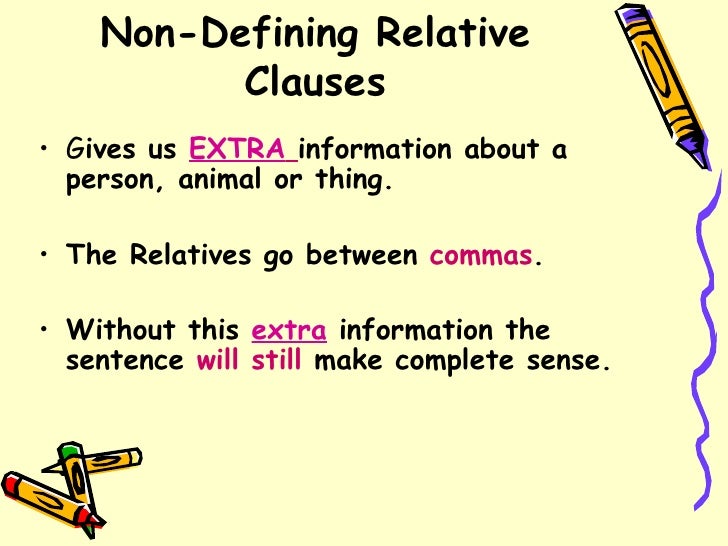non-defining relative clauses
NON-DEFINING RELATIVE CLAUSES (explicativas)
Las non-defining relative clauses se caracterizan por dar información extra sobre la persona, cosa o lugar al que nos referimos en la oración principal. La información que añaden las non-defining clauses no es necesaria para comprender a qué nos referimos y, como actúan a modo de explicación, VAN ENTRE COMAS.

EJEMPLOS
- John's mother, who lives in Scotland, has 6 grandchildren.
- My friend John, who went to the same school as me, has just written a best-selling novel.
- My grandmother, who is dead now, came from the North of England.
- We stopped at the museum, which we had never visited before.
- I've just come back from London, where John lives..
- Yesterday I met a woman named Susan, whose husband works in London.
DIFERENCIAS RESPECTO A LAS ORACIONES DE RELATIVO ESPECIFICATIVAS
En las proposiciones relativas especificativas, los pronombres "who", "whom" y "which" suelen sustituirse por "that" en el inglés hablado. Sin embargo, en las subordinadas relativas no especificativas, no es posible reemplazar otros pronombres con "that". Tampoco puede omitirse el pronombre relativo en las "non-defining relative clauses" como hacemos en las oraciones de relativo especificativas. El pronombre es necesario, incluso cuando funciona como objeto del verbo de la proposición relativa explicativa. Finalmente, las oraciones de relativo no especificativas siempre se separan del resto de la oración principal mediante comas, mientras que las oraciones de relativo especificativas no están delimitadas por signos de puntuación. JEMPLOS
- He gave me the letter, which was in a blue envelope. (proposición explicativa: había solo una carta y era azul. Es necesario emplear "which")
- He gave me the letter which/that was in a blue envelope. (proposición especificativa: había varias cartas de distintos colores y él me dio la azul. "Which" puede sustituirse por "that". Las comas desaparecen.)
- He gave me the letter, which I read immediately. (proposición explicativa: había solo una carta. Aunque "which" es el objeto de "read", debe incluirse en la oración.)
- Stratford-on-Avon, which many people have written about, is Shakespeare's birthplace. (Las preposiciones suelen colocarse al final de la oración de relativo.)
- Stratford-on-Avon, about which many people have written, is Shakespeare's birthplace. (En inglés escrito formal, también es posible colocar la preposición antes del pronombre.)
Caracteristicas de Non-defining relative clauses
- Comienza con un pronombre relativo (who, which, whose, where) pero nunca con that.
- The movie, which I saw yesterday, was awesome.
- NO:
The movie, that I saw yesterday, was awesome. - El pronombre relativo nunca se omite.
- The hotel, which is very old, is near my house.
- NO:
The hotel, is very old, is near my house. - La preposición que acompaña al pronombre relativo va al final de la clausula.
- The people, whose opinions the government is not interested in, don't agree with the new law.El pueblo, en cuyas opiniones el gobierno no esta interesado, no esta de acuerdo con la nueva ley.
- La clausula va en medio de dos comas para indicar que no escencial para su comprensión.
- This guitar, which I bought in California, is one of the niciest guitars I've ever played.
- My dog, whose name is Bear, has been with me for 10 years.
Los Pronombres Relativos
Los pronombres relativos son: who, whose, which, where.Utiliza who con personas:
- Gabriela, who is a nurse, is going to Chicago next summer.Gabriela, quien es enfermera, va a ir a Chicago el próximo verano.
- Rico, who lives in Scotland, is coming to visit me this year.Rico, quien vive en Escocia, va a venir a visitarme éste año.
Ultiliza whose con pertenencias o posesiones
whose se traduce como "cuyo", "cuya"- Brenda's brother, whose wife works for Google, is looking for another job.El hermano de Brenda, cuya esposa trabaja para Google, esta buscando otro empleo.
- Jessica, whose brother is in my class, is having a baby next month.Jessica, cuyo hermano está en mi clase, va a tener un bebé el próximo mes.
Ultiliza which con objetos:
- My desktop computer, which is a DELL, wasn't very exepensive.Mi computadora de escritorio, la cual es una DELL, no fué muy cara.
- Vida Inglés.com, which gets over a million visits a year, was launched in 2011.Vida Inglés.com, el cual recibe más de un millón de visitas al año, fué lanzado en el 2011.
Utiliza where con lugares:
- The nightclub downtown, where I met my new girlfriend, is being remodeled.El club nocturno, donde conocà a mi nueva novia, está siendo remodelado.
- The café, where we go every Saturday, sells delicious pastries.El cafÃ, donde vamos todos los Sábados, vende pastelitos deliciosos.
Recuerda:
Non-defining relative clauses:- siempre comienzan con who, whose, which, where y nunca con that
- siempre van entre comas y puede ser omitida porque no es esencial para su comprensión.
Comentarios
Publicar un comentario